Being located in the mountain valley visible in panoramic views from Sasayuri-ann of Fukano, Akame 48 waterfalls offers an exceptional dimension where you may enjoy seasonal views with natural colors and weather as well as water sound. Going by bicycle from Sasayuri-ann takes 40 - 50 minutes on going downhill and 90 - 120 minutes on returning uphill. (Going by car takes 15 - 20 minutes each way.) Seeing rustic scene while cycling is enjoyable. And it is recommended to visit such famous spots on the way as Gokuraku-ji Temple, Kashiwara Castle Ruin, House of Momochi Sandayu, and Enjyuin Temple. After waterfall trail, taking spa of Akame Onsen would be an extra refreshment. For details of waterfall trail, please see the other page in this menu: Outdoors ==> Waterfall trail.
Spiritual Mindfulness Adventure ( Akame 48 water falls )
The Forty-eight Waterfalls of Akame
(Holy place for Shugendo Mountain Buddhist Priest and birthplace of Ninja)
The Forty-eight Waterfalls of Akame were registered as one of Japan’s National Sites of Natural Beauty, and subsequently chosen as the top ranking scenic area in the waterfalls category of Japan’s Top 100 Tourist Sites. In 1970 these falls were also designated a special area of the Muro-Akame Aoyama Quasi-National Park.
Innumerable waterfalls of all sizes line the six-kilometer length of the Akame Gorge, each possessing a broad and deep pool at their base which is the characteristic feature of the Akame Falls. The area of the gorge called “Zenjun” forms the temple precincts of the Enju Cloister, which because it was protected as sacred ground since ancient times, preserves a virgin forest with a kaleidoscope of beautiful broad-leaved trees that showcase vivid hues of color in each of the four seasons.
All of the waterfalls have their own name, and because the falls were training sites for practitioners of Mountain Asceticism (Shugendo), most of these names originate in Buddhism. The major falls in the gorge include Ascetic Falls(Gyojya-Taki), Spirit-snake Falls(Reija-Taki), Immovable (Achala) Falls(Fudo-Taki), Dainichi (Mahavairocana) Falls, One-Thousand Armed (Avalokiteshvara) Falls(Senjyu-Taki), Nunobiki Falls, Ninai Falls, Meoto (husband and wife) Falls, Biwa Falls, and Gankutsu Falls.
The History of the Enju Cloister(Temple): The Entrance to the Waterfalls
The temple at the entrance to the falls is the Mt. Ohryu Enju Cloister. The Enju Cloister currently belongs to the Tendai sect of Japanese Buddhism, but according to legend it was founded some 1300 years ago by Jinben Grand-bodhisattva, otherwise known as En the Ascetic (En-no-Ozunu, 634-701), the founder of Mountain Asceticism (Shugendo). When En the Ascetic took ablutions in the waterfalls of Akame and practiced secret mysteries, Achalanatha (अचलनाथ)(Fudomyo-Oh) is said to have appeared, riding a red-eyed ox. Achalanatha is one of the vidyā-rāja, or “wisdom kings” which hold a special place in Japanese Tantric Buddhism, and were popular Buddhist objects of devotion. These deities are said to be transformation bodies of the primordial Buddha Mahavairocana. Later, this apparition of the “Red-eyed Achalanatha” was enshrined here as the guardian deity of ascetic practitioners, along with the erection of halls and shrines of a temple where the Enju Cloister still stands today. Kukai (774-835), the founder of the Shingon sect of Japanese Buddhism, practiced fire offerings to the Buddhas in the “Goma Cave” (Goma Kutsu) located in the Akame mountains, and at Mt. Myoho he also enshrined a Buddhist sutra hand copied according to strict ascetic ritual protocols.
However, in terms of historical evidence, some 900 years ago in the Shoho era (1074-1077) Kongo Busshi Shoen, a resident of Kawachi Province, received a divine message in a dream from the three avatars of the Kumano Shrines, and based on this he traveled to the area south of Nabari to Oh Falls, where he was visited by a bodily apparition of the Achalanatha. Later, Chibo Nobumasu, of Gochiku Province, confined himself in the Akame mountains for a thousand days of ascetic practice, and founded the eight halls of Mt. Ohryu Shoohryu Temple (also called Seiohryu Temple), a branch of Todai Monastery in Nara, the ancient capital of Japan.
In any event, this area prospered as a place for the practice of mountain Buddhism from the Heian period (794-1192) through the Kamakura Period (1192-1333).
Under the influence of Buddhist thought, the concept of the Pure Land of Amida Buddha became prevalent from the Kamakura period through the Muromachi Period (1392-1491) and extending to the Warring States Period (1492-1573). The Akame waterfalls had first been associated with a combination of the earlier tantric thought and the dragon cult, its many falls hidden deep in the mountains in a secluded valley, through which ran a river of depths unknown where dragons were said to lurk. From this time, however, the Akame waterfalls came to be considered a fitting place of practice for Pure Land Buddhism, the goal of which is rebirth in the Pure Land of the Amida Buddha. Accordingly, the waterfalls also became known as “the waterfalls of Amida,” with the standardized number of 48 waterfalls derived from the 48 vows of the Buddha Amida.
Later, the eight halls of the monastery were rebuilt on the order of Emperor Gosanjo (1034-1073). However, because the Akame waterfalls were the training sites of the Iga ninjas, including Momochi Sandayu (1512-1581), one of the “three great Iga ninjas,” the temple was burned to ashes in an attack by Oda Nobunaga (1534-1582), the feudal lord from Owari (today’s Aichi Prefecture) who sought to unify Japan through military conquest. All that is left from the Kamakura period are stone lanterns and a giant ridge-end roof tile inscribed with the imperial chrysanthemum crest.
In a later period, Todo Takatsugu (1602-1676), the second lord of the Ise-tsu domain), built the Kannon Hall of the Fudo Cloister, which became a special place of prayer for the Todo family. Todo Takatsugu was a lord of fervent religious faith. In the 13th year of the Kan’ei era (1636) he began suffering from cancer, and although he received treatment from many doctors, Takatsugu failed to recover and spent day after day in a deep depression.
However, one night an old monk came to Takatsugu in a dream and said to him, “You are suffering from a sickness from which it is difficult to recover, but due to the merits of your long held faith, I will save you. Do not doubt this dream! I reside in the southern corner of this province.” After saying this, the old monk suddenly disappeared.
Takatsugu awoke from the dream, and he noticed in the room’s alcove what mysteriously appeared to be the sword that the old monk in his dream had used to jab his chest. From the investigation carried out by vassals Takatsugu sent to search the southern area of the province, it was discovered that the sword gripped by the right hand of the statue of Achalanatha enshrined at the Enju Cloister had disappeared. When the description of that missing sword was compared with the one that had jabbed Takatsugu’s chest in the dream, it made for an exact match, and from this they understood that the old monk who had come to him in the dream was really the Achalanatha of Akame. From that time on, the Enju Cloister was the special place of prayer for the lords of the Todo family, and they continued their patronage until the Meiji Restoration in 1868.
The Achalanatha is enshrined as the object of devotion of the Fudo Hall of the Enju Cloister. It is said that this is a spiritually powerful icon fashioned by Saicho (767-822), the founder of the Tendai Sect of Japanese Buddhism, who carved it in the method of making three prostrations for every single cut he made in the wood. It is considered one of the three most prominent Japanese statues of Acalanātha, along with the Meguro Fudo and the Megiro Fudo which are located in Tokyo. The Fudo Hall of the Enju Cloister also enshrines Ganesha, the sixteen deities that protect Buddhism, Vaishravana, and En-no-Ozunu.
Mt. Myoho:
Sacred Mountain located in the center of the Akame Region and its Waterfalls
This area where mountain ascetics practiced from the Heian (794-1192) through the Kamakura periods has been known by various names including Mt. Myoho, Mt. Shichikin(seven gold), and Mt. Sakin(gold powder).
According to legends, while En-no-Ozunu, the founder of Shugendo also known as En the Ascetic, was practicing at the summit of this mountain, a bodily apparition of Achalanatha riding a red-eyed ox appeared to him, which is why the peak became a sacred site for mountain ascetic practitioners. It is possible to obtain a view of the rugged mountains around Fudo Falls from the peak of Mt. Myoho.
The internment of the Lotus Sutra and other sacred texts on this mountain is thought to have begun in the mid-Heian period (901-1000). But following the Kamakura period (1192 onwards) diagrams of celestial gods came alive and miraculously appeared here, and providing impressive spiritual blessings, they drew many pilgrims from all over Japan.
In that period, Mt. Myoho also became a place where people of every region in Iga Province offered hand copied sutras, and the Myoho (Wondrous Dharma) Hall is said to have been constructed on the summit. The tradition of offering hand copied sutras here continued through the end of the Muromachi period (1466-1507). Sutra offerings are not observed for the Edo period (1603-1867), but devotion to the site remained unchanged, with small mountain top shrines surviving until the first year of the Meiji period (1868). The following inscription is engraved onto a giant square rock at the summit.
Year 13 of the Keicho Era (1608) … (name unreadable) … His Holiness, Deputy Senior Assistant Monk
(unreadable) of Mt. Myoho of Iga Provice is the filial ruler
(unreadable) the four princes (unreadable) the Eiroku monarch
This inscription affirms that Mt. Myoho is a mountain of faith, a sacred mountain. Located in the center of the Akame countryside, it is the heart of the entire region, a mountain that is Akame’s very marrow. The mountain pass that is the entrance for climbing Mt. Myoho is called “Buried Sutra Mound Pass,” and on its summit we can find rocky sites like the boulder called “passage through the womb” where mountain ascetics are said to have practiced.
3D MAP for cycling from Sasayuri-ann to Akame 48 waterfalls
--- from Sasayuri-ann to Akame 48 waterfalls ---
---


We have 4 rental bikes (Taiwan’s Giant Escape RX 3) for guests.
Note: rental is free, but JPY10,000 deposit is requested which shall be returned if bicycle is returned without severe damage.
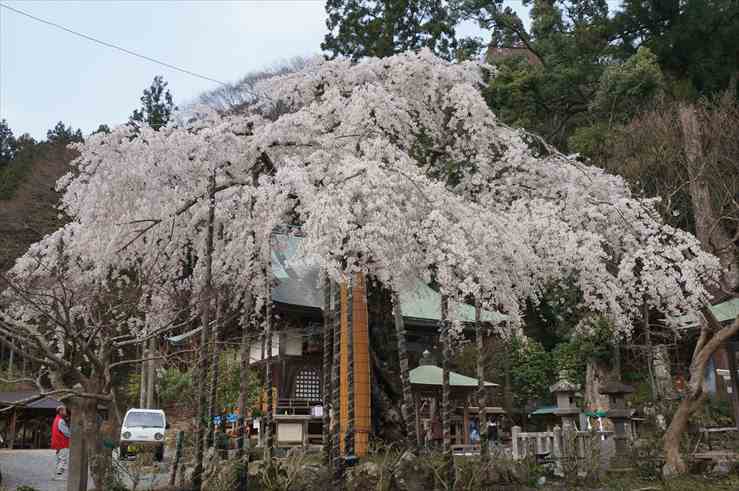
Enjyuin Temple
According to tradition, it was originally founded by “En no Ozunu” (or En no Gyoja) about 1300 years ago. He met Fudo-myoo (God of Fire) riding a red-eyed ox, when he trained under waterfall. Since then, he built the hall to enshrine Fudo-myoo as guardian god for practioners. Currently it is one of buddhism temples of tendai sect, that is famous for 300-year-old weeping cherry tree and stone lantern of Kamakura era (designated as a nationally important cultural property).
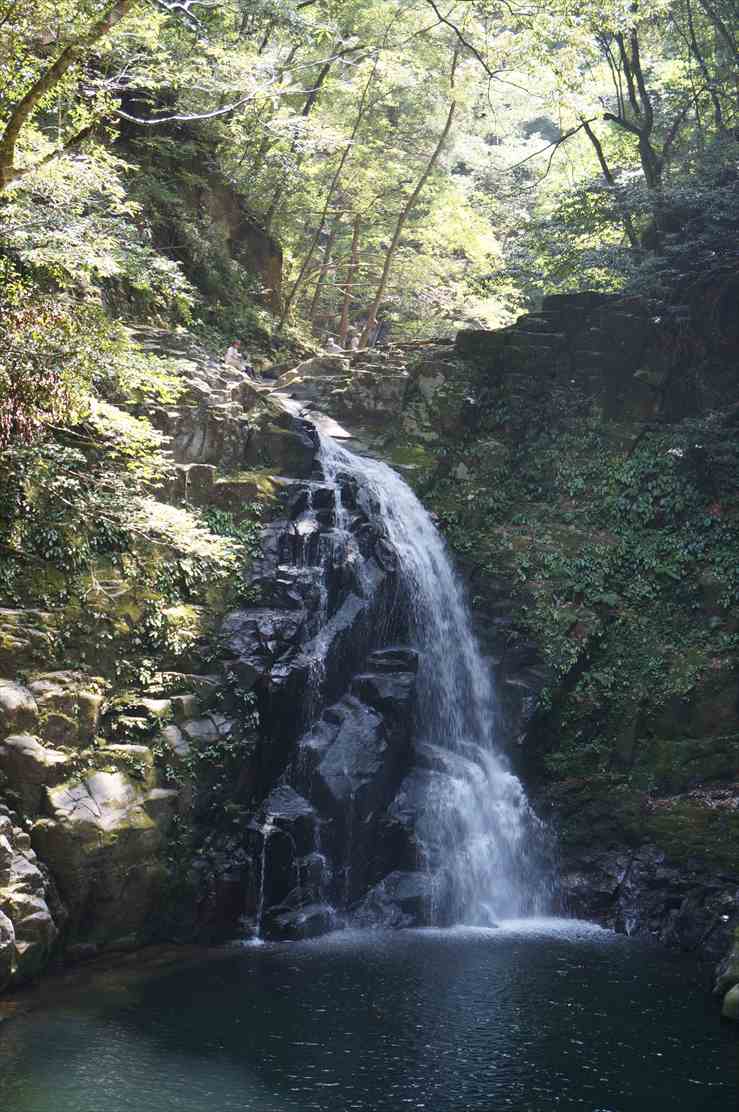
Fudo Taki Fall
One of the five largest waterfalls of Akame, with 10 m fall, 7 m width, and 10 m depth,
where "En no Ozunu” (or En no Gyoja), the legendary founder of Shugendo practiced waterfall asceticism to achieve spiritual state. Since he met Fudo-myoo (God of Fire) riding a red-eyed ox, he spread the belief in Fudo-myoo as guardian god for people.
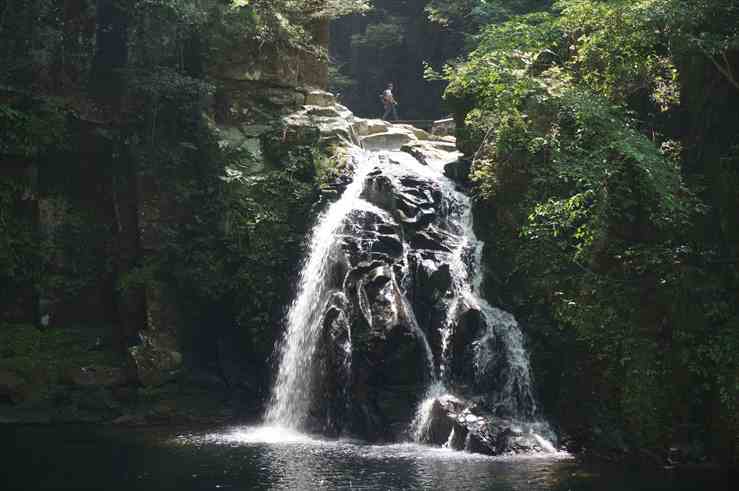
Senjyu Taki Fall
One of the five largest waterfalls of Akame, with 15 m fall, 4 m width, and 20 m depth. It was named after "Senjyu" that literally means "a thousand of hands" either because water falling looks like hands or Kannon of a thousand arms. On third Sunday of March, Akame falls worship ceremony and prayers for the hickers are carried out. 1300-year old ceremony with Buddhist "Homa" and Firewalking which tourists can participate upon advance reservation.
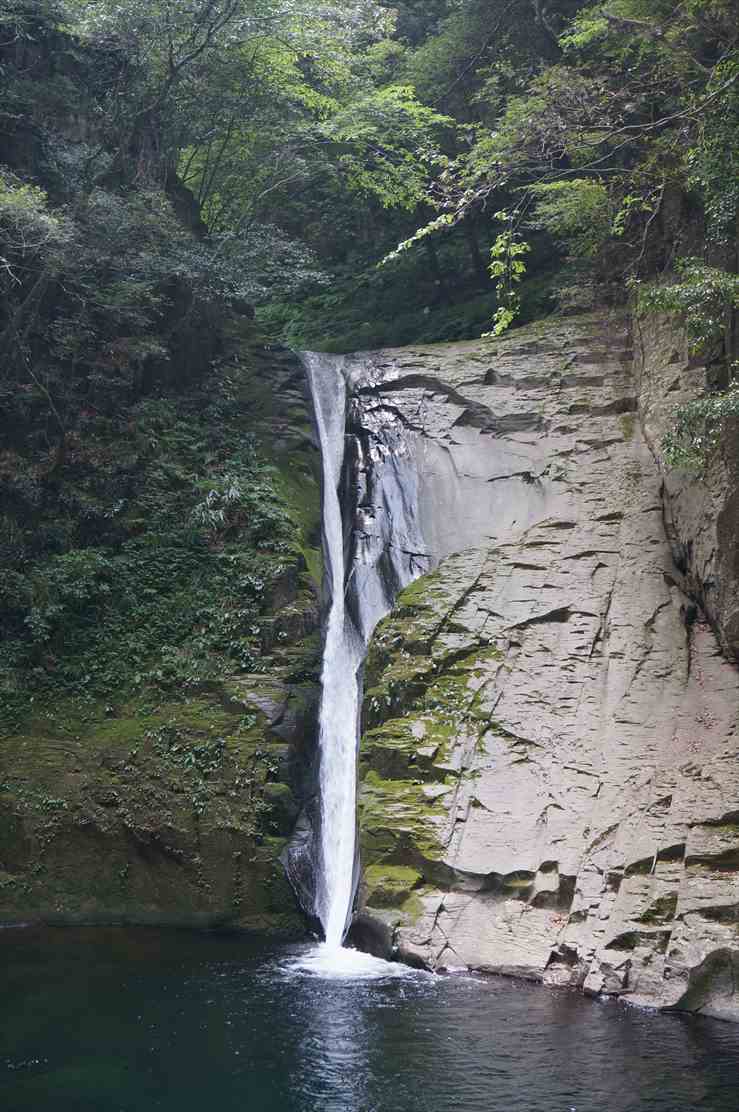
Nunobiki Taki Fall
One of the five largest waterfalls of Akame, with 30 m fall and 30 m depth.
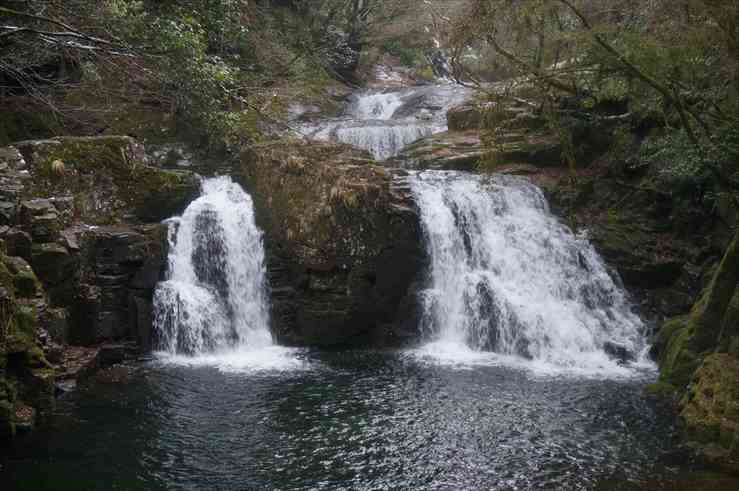
Ninai Taki Fall
One of the five largest waterfalls of Akame with 8 m fall. It was named after "ninai" that means shoulder buckets. The split falls make a great contrast to each other.
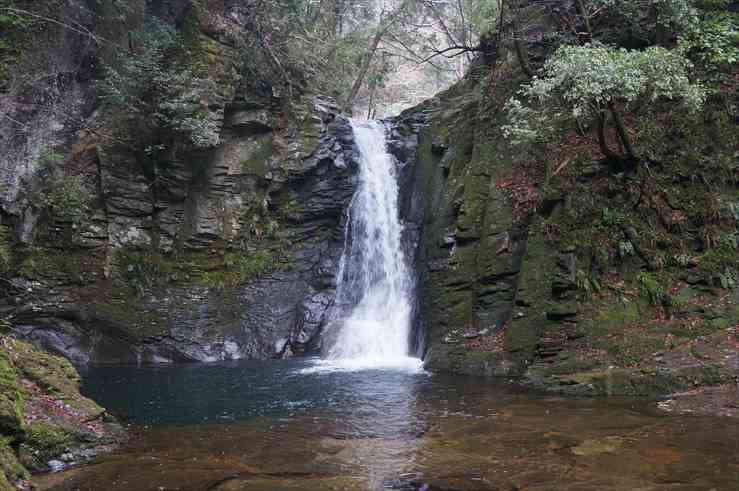
Biwa Taki Fall
One of the five largest waterfalls of Akame, with 15 m fall and 10 m depth.
The form looks like "Biwa" or Japanese lute.













